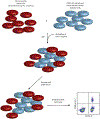Malaria Vaccine Development: Focusing Field Erythrocyte Invasion Studies on Phenotypic Diversity: The West African Merozoite Invasion Network (WAMIN)
- PMID: 26725306
- PMCID: PMC7021314
- DOI: 10.1016/j.pt.2015.11.009
Malaria Vaccine Development: Focusing Field Erythrocyte Invasion Studies on Phenotypic Diversity: The West African Merozoite Invasion Network (WAMIN)
Abstract
Erythrocyte invasion by Plasmodium falciparum merozoites is an essential step for parasite survival and proliferation. Invasion is mediated by multiple ligands, which could be promising vaccine targets. The usage and sequence of these ligands differs between parasites, yet most studies of them have been carried out in only a few laboratory-adapted lines. To understand the true extent of natural variation in invasion phenotypes and prioritize vaccine candidates on a relevant evidence base, we need to develop and apply standardized assays to large numbers of field isolates. The West African Merozoite Invasion Network (WAMIN) has been formed to meet these goals, expand training in Plasmodium phenotyping, and perform large-scale field phenotyping studies in order to prioritize blood stage vaccine candidates.
Keywords: alternative receptors; antibody inhibition assays; invasion; malaria; merozoite; vaccine.
Copyright © 2015 Elsevier Ltd. All rights reserved.
Figures



References
-
- Asante KP et al. (2011) Safety and efficacy of the RTS,S/AS01E candidate malaria vaccine given with expanded-programme-on-immunisation vaccines: 19 month follow-up of a randomised, open-label, phase 2 trial. Lancet Infect. Dis 11, 741–749 - PubMed
Publication types
MeSH terms
Substances
Grants and funding
LinkOut - more resources
Full Text Sources
Other Literature Sources

